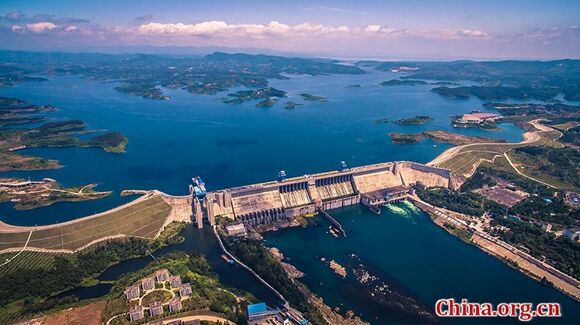A total of 22.2 billion cubic meters of water has been diverted through the eastern and central routes of the South-to-North Water Diversion Project as of Dec. 12.

Since the opening of the first phase of the central route on Dec. 12, 2014, China's water diversion project has greatly increased the water supply, and the water resources are better allocated, which is of great significance to ecological advancement.
Clear water now runs swiftly along the Hutuo River, with trees growing on the both sides. It's hard to imagine that this river, located in the suburban area of Shijiazhuang city, Hebei province, had been dried up for many years before the water diversion project launched. Shi Xiaoxu, who lives by the river, said that there used to be a big sandpit. "I went to the high school across the river. Dust and sand was everywhere when the cars passed. But after these years' management, the traffic and environment improved, and people find more places to entertain. I always bring my kids here on the weekends."
This year, water is being diverted to the Hutuo River, the Fuyang River, and the Nanjuma River, according to the Department of Water Resources of Hebei Province. The central route of the South-to-North Water Diversion Project has diverted water into the three rivers since Sept. 13, and the speed of water supply in the Hutuo River now reaches 85 cubic meters per second.
As of November, data from 119 underground water inspection stations shows that the water level of the three rivers has risen 0.5 meters on average, with the Hutuo River rising the most, according to Xin Ge, vice inspector from the Department of Water Resources of Hebei Province.

In addition to the water supply, the water quality has also been improved with the help of the water diversion project. "The citizens all use the water from the project, and the water quality is quite good and the water tastes better," said Du Xiaona, a Shijiazhuang citizen.
The first phase of the central route of the South-to-North Water Diversion Project has continuously provided water supply for 1,461 days, transferring 19.1 billion cubic meters of water, and supplying 3.1 billion cubic meters of water to Shandong province. It took the first phase of the eastern and central routes of the water diversion project three years to divert 10 billion cubic meters of water, and only another year for the project to divert the next 10 billion cubic meters of water.
"The project has improved the water supply of cities along the route, which has already become a major water source for over 40 large and medium cities in Beijing, Tianjin, Hebei province, Henan province and Shandong province, benefiting more than 100 million people. The central route has benefited over 53 million people, and the eastern route has benefited more than 66 million people. The project has already covered the whole Jiaodong Peninsula," Yuan Qitian, deputy director of department of South-to-North Water Diversion Project, said.
Yuan said the next steps of the project will be aimed at solving problems with regard to water shortage, ecological damages, and pollution, providing more quality ecological products, in order to satisfy people's needs for a good environment and promote ecological advancement.